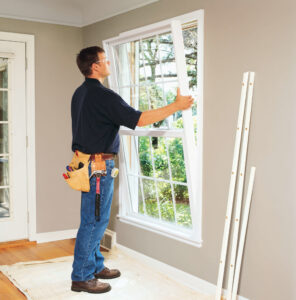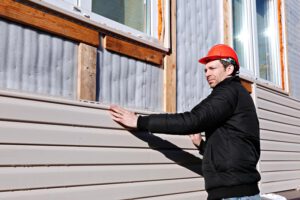Replacement Windows aren’t something homeowners think about until it becomes necessary. Dated styles, air infiltration, and thermal leaks are just a few of the issues that signal the need for new windows.

Insert replacement windows into an existing frame, leaving the original trim and siding intact. They’re also available in flush-flange versions with a more streamlined look.
When potential buyers look at a house, the first thing they notice is the curb appeal. If the home looks run down or in need of repairs, they will quickly walk away or scroll to the next listing. Fortunately, there are simple things you can do to give your home a curb appeal boost.
Replacement windows can add to the overall curb appeal of your home. They are available in a variety of styles, materials and colors to match your home. They also don’t require a lot of work to install. They are designed to fit right into your existing window frames without any changes to the wall, trim or siding. This is a big advantage for homeowners with older homes, who don’t want to disturb the original architectural features.
New replacement windows are also a great option for homeowners who want to add more light to the front of their home. These windows can be combined with a range of options like awning and casement windows to create the perfect look for any home.
Repainting your door and garage doors is another easy way to add some curb appeal. You can choose a color that will highlight the best features of your home and draw in more buyers.
Planting flowers is a quick and inexpensive project that can dramatically improve your home’s curb appeal. Picking out flowers that will compliment the style of your home is essential, and choosing a color scheme that is in season when you plant it will make your flower beds pop. You can also add some curb appeal by installing a porch swing or other furniture to give your home a cozy and welcoming feel.
Increased Energy Efficiency
In many homes, the windows are a major source of energy loss. Upgrading your windows to energy efficient models can help lower your heating and cooling costs and reduce your carbon footprint. New windows also provide added security to your home, as they have high-security locking built in.
Unlike a traditional single-pane window, replacement windows have multiple layers of glass with an insulating gas in between. This helps shield your home from outdoor elements, support temperature control and offer noise dampening benefits.
When choosing a new window, look for the ENERGY STAR label. This means that the product meets strict energy efficiency guidelines set by the EPA and has been independently tested, certified and verified by the National Fenestration Rating Council (NFRC).
A new window can be the perfect way to improve your home’s appearance while increasing its value at the same time. Many brands offer a wide variety of exterior and interior finishes, so you can find the right look to complement your home’s style. In addition, new windows are designed to be easy to open and close, which can make your life easier and keep your home comfortable.
If you’re considering selling your home in the future, new windows can increase its value and appeal to potential buyers. Energy efficient windows are a sought-after feature in new homes, and they can save homeowners money on energy bills. Additionally, a well-maintained, high-quality window will look better and last longer than an older, less energy-efficient model.
Increased Home Value
There are a few different windows that can be used in your home. The two most common types are new construction and replacement windows. New construction windows are typically installed when building a house or adding an addition. They are also usually used in houses that have existing siding and trim.
Replacement windows are designed to fit into an existing window frame. They can be installed in either a full-frame replacement or pocket replacement method. The best option for you depends on the condition of your current windows and what your goals are.
A full-frame replacement is a more invasive method of installation. It requires removing the existing window, frame and moldings so that the contractor can install new materials and nail fins. This is the type of project that is recommended when the existing window and frame are in poor condition.
Nail fins are metal strips that help secure the window to the sheathing before shims and frames are installed. These are typically included with new construction windows but can be purchased separately for replacement windows.
There are many benefits to using replacement windows. They are often less expensive than new construction windows and are installed in a way that does not require major alterations to the siding or trim of your home. This makes them a great choice for older homes that may have period features that you want to maintain. Additionally, replacement windows are a good option for homeowners that use window air conditioners. New construction windows do not accommodate these units and can cause stress on the frame. This can lead to leaking and rot over time.
Increased Comfort
Having comfortable temperatures in your home isn’t just good for you; it helps everyone else who lives there. New replacement windows provide superior insulation, keeping your home cool in summer and warm in winter, while reducing energy usage. Plus, new windows with argon gas between double or triple panes help prevent drafts and reduce the number of UV rays that enter your home.
Outside commotion makes it hard to relax and enjoy your home, whether it’s traffic sounds, neighbors mowing their lawns, or even planes flying overhead. With new windows that minimize outside noise, your house can be a peaceful oasis where you can rest and recharge with the people you love most.
Old windows often become squeaky and difficult to open or close over time, and that can make your home less safe. But modern replacement windows can be easier to open, close, and lock, improving the safety of your family and guests.
It’s nearly impossible to feel truly at home if your home doesn’t feel safe and secure, especially at night. New windows that lock easily and reliably, especially those with built-in child safety locks, can help you sleep more soundly each night, knowing that everyone under your roof is safe.
Increased Natural Light
When old windows begin to show signs of wear, it’s important to replace them. This investment will not only make your home more energy efficient and comfortable, but it will also increase its value. New windows will bring in more natural light, which can help improve the look of your home and boost your mood.
In addition, more natural light will decrease your electricity bill by allowing you to keep the lights off during the day. Natural light can also reduce fading on furniture, carpeting, and artwork, as well as help your home look more open and welcoming to guests.
While many people know that replacing their home’s windows can improve their curb appeal and bring up its value, they often overlook the benefits that come with increased natural light. A brighter, more welcoming home is sure to impress visitors and can greatly improve your family’s mood and overall health.
To maximize natural light, consider window replacement with larger glass areas or adding skylights to your home. Bay and bow windows are ideal for bringing in a deluge of sunlight, while casement windows feature wide frames that open from a single hinge located on the side, providing maximum air circulation. Additionally, special shape windows such as trapezoids and triangles fit perfectly above double hung windows to add more daylighting.
In addition to increasing natural light, new windows can also decrease outside noises. This can be a major benefit for homeowners who live in noisy neighborhoods or are near busy roadways. Noise reduction can not only reduce stress, but it can also improve your sleep quality and overall mood. Whether you’re entertaining friends or just relaxing with your family, your home should be your oasis of peace and comfort.
